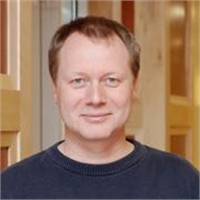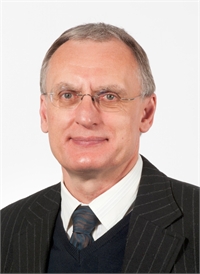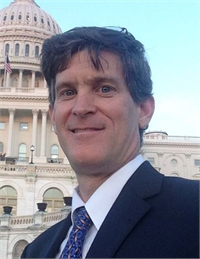Latest Past Events
Ramsey-Bordé Interferometer for Electrons
MIT Lincoln Lab 3 Forbes Road, LexingtonProf. Karl-Peter Marzlin St. Francis Xavier UniversityIn a Ramsey-Bordé interferometer for atoms, an atomic beam is split and recombined by exploiting the momentum transfer that atoms obtain when they absorb and emit light from a carefully arranged set of laser beams. Ramsey-Bordé interferometers are very flexible because they do not require mechanical gratings. They can be set up to eliminate the influence of unwanted effects, such as the reduction of fringe visibility due to the Doppler effect. In this talk, a proposal for a Ramsey-Bordé interferometer for electrons is presented, in which the Kapitza-Dirac effect for counter-propagating laser pulses is used to transfer a specific amount of momentum to electrons. As an application of such an interferometer, the measurement of relativistic Lorentz contraction of the distance between two interferometer arms will be discussed. For electrons that have been accelerated to relativistic velocities, this contraction will prevent the recombination of the two paths and thus reduce fringe visibility. The proposed experiment may be considered as a realization of Bell's spaceship paradox in electron interferometry.Peter Marzlin received his PhD in 1994 from the University of Konstanz, Germany, where he worked on atom interferometry in curved space under the supervision of Jürgen Audretsch. After postdoctoral positions in Konstanz and at the Macquarie University in Sydney, he received the Habilitation for Theoretical Physics in 2001. He worked as senior researcher at the Institute for Quantum Information Science at the University of Calgary for five years before he joined St. Francis Xavier University in 2008. He is currently Chair of the Department of Physics.Registration is closed.
Quantum Sensors Based on Interferometry
MIT Lincoln Lab 3 Forbes Road, LexingtonProf. Alexander V. Sergienko Boston UniversityInterferometric sensing today is a broad area of modern photonics and ubiquitous technology that could be found in all brunches of science and technology. Major interferometric approaches are based on the use of such physical parameters as phase, group velocity, and polarization. They serve as a base to multiple interferometric devices including free-space and fiber-optic sensors. Quantum optics concentrates on the use of non-classical states to access new physical properties unseen in the classical behavior of light. Starting originally with a quantum curiosity and Bell’s inequality violation, the utilization of quantum optical entanglement progressively evolved into creation of interferometric sensors that are superior in resolution and sensitivity when compared with classical counterparts. We will discuss the role of interference effects in quantum optics, generation, manipulation and detection of optical entanglement. Quantum effects of dispersion cancellation and decoherence-free subspaces become new tools for designing quantum optical sensors. Several interferometric sensing approaches based on the use of entanglement in frequency, polarization, and in the number of photons will be considered.Professor Alexander V. Sergienko (e-mail: [email protected]; URL: http://people.bu.edu/alexserg) received his Ph.D. degree in physics from Moscow State University in 1987. He spent 1990-1996 at the University of Maryland and at the National Institute of Standards and Technology (NIST) in Gaithersburg, Maryland. Professor Sergienko holds joint appointments in the Department of Electrical and Computer Engineering, in the Photonics center, and in the Department of Physics at Boston University. His research interests include quantum information processing including quantum cryptography, communication and computing, quantum networking, quantum imaging, the development of novel ultra-precise optical-measurement and characterization techniques (quantum metrology) that are based on the use of non-classical states of light. He pioneered the experimental development of practical quantum-measurement techniques using entangled-photon states. Professor Sergienko has published more than 400 research and conference papers and holds 6 patents in the fields of experimental quantum optics and entanglement manipulation. He is the editor of "Quantum Communications and Cryptography" (CRC/Taylor & Francis, 2006) and co-author of “Quantum Metrology, Imaging, and Communication" (Springer, 2017). He is a Fellow of the Optical Society of America, a member of the APS and IEEE.Registration is closed.
Atom Interferometer Measurements using Nanogratings
MIT Lincoln Lab 3 Forbes Road, LexingtonProf. Alexander D. Cronin University of ArizonaNanofabricated gratings enable atom interferometry with multiple elements. I will discuss measurements of atom-surface van der Waals (Casimir-Polder) potentials for Li, Na, K, Rb and Cs atoms interacting with silicon nitride surfaces , measurements static electric dipole polarizabilities for Na, K, Rb, and Cs atoms , and measurements of a tune-out wavelength (i.e. a root in the dynamic polarizability) for K atoms . I will discuss our polarizability measurements in more detail and show how these can be used to report the Cs 6P J=3/2 atomic lifetime T = 30.37(3) ns with unprecedented uncertainty. These measurements demonstrate benefits of a universal interferometer that uses nanogratings to diffract and recombine de Broglie waves of many atomic and molecular species, as well as electrons and neutrons . PRL 95, 133201. PRL 105, 233202. PRA 81, 053607. PRA 92, 052513. Atoms, 4(3), p.21. PRL 109, 243004. PRA 95, 052507, PRA 74, 061602. NJP 11, 033021. PRL 120, 113201.Alex Cronin is a Professor of Physics at the University of Arizona, where he has worked since 2002. He received a BS in Physics from Stanford University in 1993, and a PhD in Physics from the University of Washington in 1999 under Norval Fortson. He was a postdoc at MIT from 1999-2002 in Dave Pritchard's atom interferometry group. Cronin won a Distinguished Teaching Award from the University of Arizona College of Science in 2008, and the Koffler Prize for Teaching at the University of Arizona in 2009. Cronin was a Faculty Fellow at the Udall Center for Studies in Public Policy in 2015, and served as a Program Director at the National Science Foundation during 2016-2018.Registration is closed.



